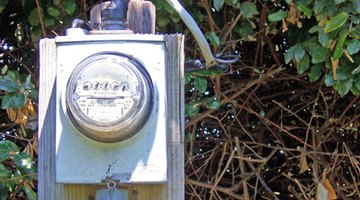Parts & Function of Kilowatt Hour Meter
Energy meters refer to devices designed to calculate the amount of electrical energy used by offices and residences. Kilowatt-hour meters are one type of frequently used energy meter.

Parts
A kilowatt-hour meter contains an aluminium disc, which is supported by a spindle with a worm gear. The worm gear drives the register, or series of dials used to record how much energy is used. The kilowatt-hour meter also contains coils, which work in conjunction with the disc, and a permanent magnet.
Function
Kilowatt-hour meters calculate electrical energy consumption in billing cycles, which are measured in kilowatt-hours, or units of energy equivalent to 1,000 watt-hours. Periodic readings taken by kilowatt-hour meters establish billing cycles utilized by utility companies.
Operation
One coil connects to the disc and creates a magnetic flux in proportion to the voltage received. The other coil generates a magnetic flux proportional to the current. The voltage coil’s magnetic field is delayed via a lag coil, which results in eddy currents flowing through the disc. These currents exert force on the disc proportional to the coil's current and voltage. A permanent magnet exerts an opposing force on the disc. These forces result in a disc-speed rotation proportional to the power generated. The disc activates a register device, which counts disc revolutions in order to calculate energy consumption.
The Drip Cap
- Energy meters refer to devices designed to calculate the amount of electrical energy used by offices and residences.
- These currents exert force on the disc proportional to the coil's current and voltage.
- The disc activates a register device, which counts disc revolutions in order to calculate energy consumption.
References
Photo Credits
- electric meter image by palms from Fotolia.com
- electric meter image by palms from Fotolia.com
More Articles



